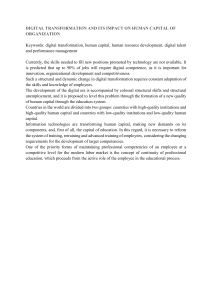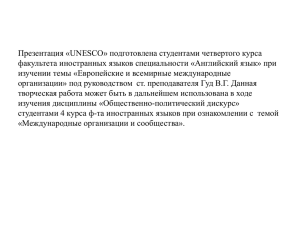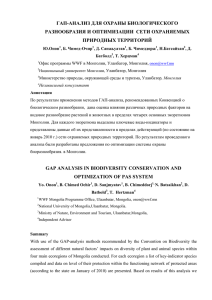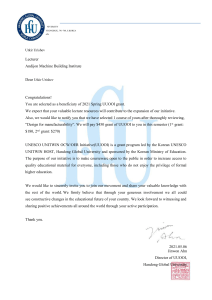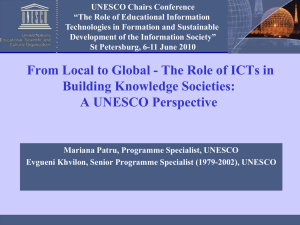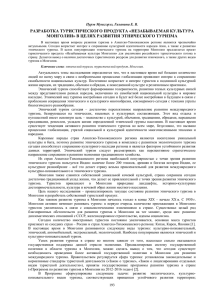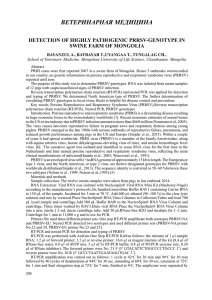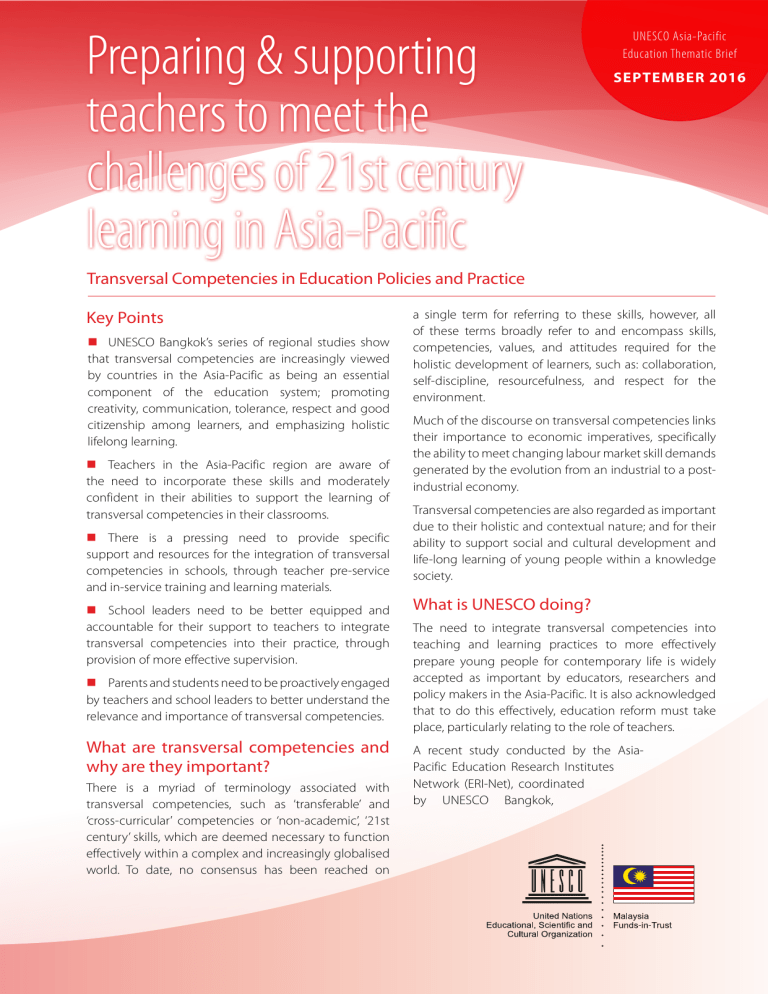
Preparing & supporting teachers to meet the challenges of 21st century learning in Asia-Pacific UNESCO Asia-Pacific Education Thematic Brief SEPTEMBER 2016 Transversal Competencies in Education Policies and Practice Key Points n UNESCO Bangkok’s series of regional studies show that transversal competencies are increasingly viewed by countries in the Asia-Pacific as being an essential component of the education system; promoting creativity, communication, tolerance, respect and good citizenship among learners, and emphasizing holistic lifelong learning. n Teachers in the Asia-Pacific region are aware of the need to incorporate these skills and moderately confident in their abilities to support the learning of transversal competencies in their classrooms. n There is a pressing need to provide specific support and resources for the integration of transversal competencies in schools, through teacher pre-service and in-service training and learning materials. n School leaders need to be better equipped and accountable for their support to teachers to integrate transversal competencies into their practice, through provision of more effective supervision. n Parents and students need to be proactively engaged by teachers and school leaders to better understand the relevance and importance of transversal competencies. What are transversal competencies and why are they important? There is a myriad of terminology associated with transversal competencies, such as ‘transferable’ and ‘cross-curricular’ competencies or ‘non-academic’, ‘21st century’ skills, which are deemed necessary to function effectively within a complex and increasingly globalised world. To date, no consensus has been reached on a single term for referring to these skills, however, all of these terms broadly refer to and encompass skills, competencies, values, and attitudes required for the holistic development of learners, such as: collaboration, self-discipline, resourcefulness, and respect for the environment. Much of the discourse on transversal competencies links their importance to economic imperatives, specifically the ability to meet changing labour market skill demands generated by the evolution from an industrial to a postindustrial economy. Transversal competencies are also regarded as important due to their holistic and contextual nature; and for their ability to support social and cultural development and life-long learning of young people within a knowledge society. What is UNESCO doing? The need to integrate transversal competencies into teaching and learning practices to more effectively prepare young people for contemporary life is widely accepted as important by educators, researchers and policy makers in the Asia-Pacific. It is also acknowledged that to do this effectively, education reform must take place, particularly relating to the role of teachers. A recent study conducted by the AsiaPacific Education Research Institutes Network (ERI-Net), coordinated by UNESCO Bangkok, plic ati ce on Reflec fu rs lne lls inking Critical and innovative thinking Reasoned decision making ss Awareness and openne t ing ra ee eo or ns tf se ec sp l id en tit ya nd Re na sio n d co l l e gi ality cip lin e Em pat hy and com pas s nes are aw elf- nd e a ranc rve erse tion tiva -mo self P Compassion ICT Abi eva lity to and luate critic me info ally rm dia con atio ten n t Na tio Other skills as defined by countries/ economies th elo oc m De Other en pa n nm an tic xi d an in on ta ati ob o orm y t inf T ilit se IC Ab aly gh an rou th al ic Eth rt u erc nt di da an Ethical use of io at p ici ng lu ra ltu d an rst e nd ity bil y ilit tab p da Integrity and self-respect Media and information literacy Global citizenship ing iro ilit lv reso nv y to nsib po Res What are transversal competencies? t nflic e co d ab an ility Intrapersonal skills fb e and re lea pe de in S ity r divers spect fo y to Fle Interpersonal skills ski rn ilit Ab p ss tive th c Toleran Soci abili ty an hi Se lfdis eu ls skil Ap ur kills tio n n ica so en Teamwork and collaboration mu pr ity tiv ea Cr tre Re nal s izatio Organ Com En ly nt e nd Source: School and Teaching Practices for Twenty-first Century Challenges: Lessons from the Asia-Pacific Region, (UNESCO, 2016). examined to what extent teachers feel prepared and supported to integrate transversal competencies into their classroom practice. What are the implications of transversal competencies for teaching and learning? The working definition of transversal competencies adopted by ERI-Net as a basis for this research is divided into five domains and one optional domain, including: (i) critical and innovative thinking; (ii) inter-personal skills; (iii) intra-personal skills; (iv) global citizenship; (v) media and information literacy; and (vi) other skills as defined by countries/economies. For teachers to teach transversal competencies they need to understand and exemplify them. To this end, teachers must become ‘knowledge workers’, who expand and share their professional knowledge with peers and with students. More specifically, teachers need the ability to integrate competencies across traditional academic curriculum, and to deliver these competencies as standalone subjects in the classroom and/or as extracurricular activities. This brief summarizes the key findings1 and policy recommendations from Phase III of ERI-Net’s research into transversal competencies in education policy and practice. The research was conducted across nine countries in the Asia-Pacific including: Australia, China (Beijing, Hong Kong Special Administrative Region and Shanghai), India, Japan, Malaysia, Mongolia, Republic of Korea, Thailand and Viet Nam in 2015-16. The results herein are based on limited sample size from country case studies and therefore cannot claim to reflect regional trends or be fully representative of the population of the countries or of the entire region. 1 The integration of transversal competencies in the classroom requires teachers to change from being transmitters of knowledge to facilitators of knowledge. As part of this change, teachers need to adopt studentcentred learning approaches, based on collaborative team-based learning. Teachers need also to equip students with the skills to learn and inquire for themselves, by striking a careful balance between ensuring students are equipped with core academic knowledge and facilitating the development of higher-order thinking and problem-solving skills that lead to the ability to learn throughout life. How are teachers being supported to integrate transversal competencies in to their practice, and what challenges do they face? Key findings from quantitative and qualitative data provided by over 400 schools and from approximately 2621 respondents, 95 per cent of whom were teachers, across the Asia-Pacific region, are drawn upon in examining this question. Teacher Preparedness In most of the country case studies, the majority of teachers are moderately confident in their abilities to support the learning of transversal competencies while low confidence is an issue for some of the teachers, ranging from 3 per cent in Mongolia to 18 per cent in the Republic of Korea. Interviews with teachers reveal low confidence is often caused by being overwhelmed by competing demands on their time, such as the need to utilise numerous mandated learning frameworks in their practice, and increasingly burdensome management and administrative tasks. Majority of teachers in this study perceived passion for teaching and communication skills as being essential and which they are most equipped with in facilitating transversal competencies learning. Reflective thinking was identified as a most needed skill by teachers in Australia and China (Beijing and Hong Kong SAR). Critical thinking had the lowest response in four countries, including India, Mongolia, Thailand and Viet Nam, when teachers were asked to identify skills and competencies they feel they are equipped with in facilitating transversal competencies learning. Differences in teacher views may be due to different understandings of what transversal competencies actually are. Professional Development For pre-service professional development training, teachers identified the practicum component as the most helpful in facilitating transversal competencies learning, compared with course work and induction programs. For in-service professional development training, the majority of teachers expressed satisfaction with the current training they receive, however a sizeable minority are dissatisfied with the training offered as there are few training programs that specifically tackle transversal competencies learning. In terms of forms of professional development, there was an overall consensus amongst teachers in the participating countries that forms of school-based training, such as exchanging ideas with colleagues, lesson study and peer coaching, are the most relevant for helping them learn how to facilitate transversal competences learning. The majority of teachers in a majority of countries, including China (Beijing, Hong Kong SAR), Japan, Republic of Korea, Mongolia and Thailand, confirmed that they receive in-service training relatively frequently, most commonly at least once or twice a semester. An assessment of the perceived effectiveness of this training, however, revealed notable gaps. Teachers overwhelmingly expressed the view that more specific training on the facilitation of transversal competencies learning is needed, together with greater access to transversal competencies-enriched learning materials. School-level and systemic support The effectiveness of professional development for teachers was further examined with reference to key components of the school as an institution, and its broader systemic environment. At school level, while the majority of teachers responded that transversal competencies were either implicitly or explicitly reflected in their school plans, the implementation of these plans is a challenge according to some due to a lack of school budget. Insufficient and unallocated school budget to support teacher training and the purchase of necessary learning materials to facilitate transversal competencies learning was mentioned as a specific concern by teachers from Republic of Korea and Japan. Furthermore, teachers expressed frustration at a lack of access to detailed guidelines and good practice examples to assist them with transversal competencies learning, and identified a lack of a specific assessment framework to measure transversal competencies attainment as a further hindrance. Teachers identify a crucial role for school leaders in ‘rebalancing’ the school environment from one that is dominated and driven by traditional academic subjects that are exam-orientated to one that is more inclusive of transversal competencies teaching and learning. School leaders are perceived by teachers to be generally supportive of their efforts to integration transversal competencies in to their practice. A majority of teachers across seven countries, including Australia, China (Beijing and Hong Kong SAR), India, Japan, Mongolia, Thailand and Viet Nam) felt that their professional development training is proactively supported by school leaders. However, some teachers identified difficulties with school leader attitudes relating to the teaching of transversal competencies, such as a lack of understanding and knowledge of what transversal competencies are, and of the challenges faced by teachers in facilitating them. Additionally, lack of quality supervision from school leaders was noted in the research. Parents and students are perceived by teachers across the region to value academic success in assessed traditional subjects over non-traditional areas of learning, like transversal competencies. These attitudes make ‘rebalancing’ school environments a significant challenge. As researchers of the China (Shanghai) case study found, student interest and parental support are identified by teachers as two of the most influential factors for enabling the effective teaching of transversal competencies in schools. At a systems level, significant effort is underway on the part of some education authorities to move from a focus on improving the quantity of in-service training towards improving its quality. Furthermore, the research revealed a clear strategic commitment from several education authorities to establish a progressive vision of education, encompassing transversal competencies. Policy recommendations Expand opportunities for teacher professional development in transversal competencies learning. n Work with teacher education institutions to improve the quality of pre-service training by ensuring that pedagogy for transversal competencies are explicitly taught and assessed as part of practicum, course work and induction program training components. n Create in-service training programs that provide initial and grounded support through: (i) fostering teacher understanding of what transversal competencies are and how teacher roles need to change to effectively implement them; (ii) supporting teachers to develop critical skills that are essential for transversal competencies teaching; and (iii) providing relevant and good practice examples of how to teach transversal competencies. Enhance school environments to better enable teachers to implement transversal competencies learning in their practice n Ensure there is sufficient budget at school level to support teachers’ access to quality professional development and specific teaching and learning materials on transversal competencies learning. n Provide professional development training to school leaders to: (i) help them establish school environments that are conducive to transversal competencies learning; (ii) to build their knowledge and understanding of what transversal competencies are, and of optimal ways they should be implemented. n Make school leaders accountable through professional performance appraisal processes for: (i) establishing a school environment that is conducive to the teaching and learning of transversal competencies; and (ii) for the quality of supervision that they provide to teachers. Provide system-level support to better guide the integration of transversal competencies in schools. n Prioritize a sufficient proportion of local education budgets to support the full integration of transversal competencies in all schools. n Conduct a curriculum review to create more synergy for the teaching of transversal competencies, and to more realistically balance teacher workloads. n Create curriculum guidelines to assist teachers to integrate transversal competencies into their practice, and to actively identify and disseminate good practice examples of competencies teaching and learning. n Develop an assessment framework, with advice from teachers and teacher education institutions, to ensure that learning against transversal competencies is meaningfully assessed. Build understanding and advocate the value of transversal competencies within school communities. n Organize transversal competencies advocacy with local education officials, school administrators, school leaders, and teachers. n Equip school leaders with knowledge and understanding of transversal competencies and resources to effectively advocate their importance to parents and students. This is a summary of ERI-Net’s Phase III research into transversal competencies in education policy and practice. The regional synthesis report will be published in December 2016. Published in 2016 by the United Nations Educational, Scientific and Cultural Organization, 7, place de Fontenoy, 75352 Paris 07 SP, France and UNESCO Bangkok Office © UNESCO 2016 This publication is available in Open Access under the AttributionNonCommercial-ShareAlike 3.0 IGO (CC-BY-NC-SA 3.0 IGO) license (http:// creative­commons.org/licenses/by-nc-sa/3.0/igo/). By using the content of this publication, the users accept to be bound by the terms of use of the UNESCO Open Access Repository (www.unesco.org/open-access/terms-use-ccbyncsa-en). THA/DOC/IQE/16/36-E
